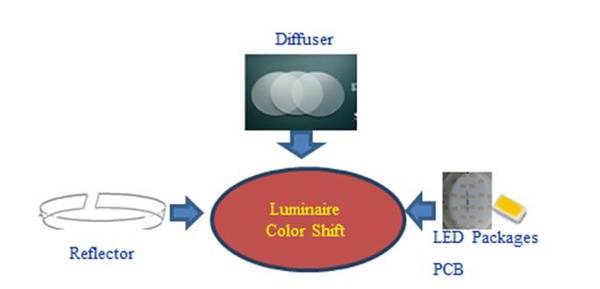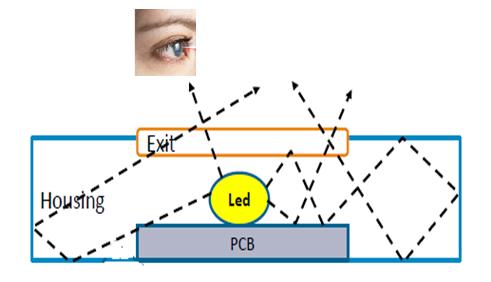
Task 1 Reliability and lifetime
Realisations:
1. An Accelerated Lumen Depreciation Testing Method
Light emitting diodes (LEDs), made by combining phosphor with the blue light sources, are the most commercially available solid state light sources. Therefore, a high accelerated stress testing (HAST) set-up to study the effects of both blue light intensity and the thermal stress on the lifetime and the kinetics of aging of phosphor plates used in SSL luminaires has been chosen to work out the Reliability and Life Time Prediction of Remote Phosphor Plates in Solid State Lighting Application.
 |
Result:
By increasing the power of light, temperature of phosphor increases leading to the larger the depreciation rate. The results also show that there is a direct relation between the temperature and the loss in conversion efficiency of package. In fact, by increasing the ageing temperature the conversion efficiency decreases. The ageing of BPA-PC, used as substrate in remote phosphors, is faster than the phosphor itself. The decrease in the intensity of the blue light takes place with a faster kinetics, compared to that of the yellow peak. Our results show that the generalized Eyring equation can well describe the degradation kinetics of the remote phosphor component.
2. POF Based Breakdown Method for LED Lighting Colour Shift Investigation
Unlike traditional lighting products, the colour shift mechanism of LED lighting is complex due to its much more comprehensive structure, generally composed of LED die, phosphor, silicone, reflector, diffusers, and so on, all of which may contribute to the colour shift during operation probably and each individual component has its own degradation mechanism. Studies on the LED based luminaire level colour shift reliability are very rare and if available then based on the statistical (data-driven) method while we propose a Physics Of Failure (POF) method instead.
 |
3 experimental conditions were applied to speciments: 1) Thermal aging in an aging test oven with a temperature setting of 85ºC for more than 3000 hours; 2) Blue light irradiation at 85ºC for more than 3000 hours and 3) The specimens were placed inside the oven at 85 ºC and exposed to blue light through the oven glass window generated by the blue light LEDs outside the oven.
Result:
Such a breakdown method can be used to investigate the colour shift failure mechanisms and quantify the colour shift effects of each individual part for the total luminaire level products. The LED packages part plays a key role in the colour shift contribution for the downlight investigated. Both humidity and temperature conditions can be used to accelerate the colour shift and the humidity performed in this research has a stronger acceleration, compared to the sole temperature aging.
3. A Novel Approach for Colour Shift Investigation on LED-based Luminaires
This study will propose a view factor approach for colour shift investigation on LED- based luminaires, which will pave way for the future colour shift prediction.
 |
Result:
The approach proposed in this study can be easily used to extract the colour shift contribution of each individual component for LED luminaires. The colour shift caused by the diffuser (due to wavelength dependent transmission) is the major contribution to the 0h colour shift of the luminaire investigated, and reflector has little impact on the total colour shift. After aging at high temperature for around 3000 hours, a small colour shift of the luminaire observed, caused by degradation of both LED packages and diffuser.
Publications and presentations
3 Publications have been submitted/published:
1) Jianlin Huang, Dušan SGolubović, SauKoh, DaoguoYang, XiupengLi, XuejunFan, G.Q.Zhang, Lumen degradation modeling of white-light LEDs in step stress accelerated degradation test , Reliability Engineering and System Safety 154 (7 June 2016, online), 152–159;
2) Bo Sun, Xuejun Fan, Lei Li, Huaiyu Ye, Willem van Driel and Guoqi Zhang, A Reliability Evaluation for Electrolytic Capacitor Free LED Driver, IEEE transaction on Components, Packaging and Manufacturing Technology, submitted;
3) Jiajie Fan, Cheng Qian, Mengni Zhang, Yun Li, Xuejun Fan, Guoqi Zhang, Thermal/Luminescence Characterization and Degradation Mechanism Analysis on Phosphor-converted White LED Chip Scale Packages, Microelectronic Reliabilit, submitted;
Some results will be also presented during the final Stakeholder workshop in May 2017 in METAS, Wabern (refer to Final Stakeholder Workshop).